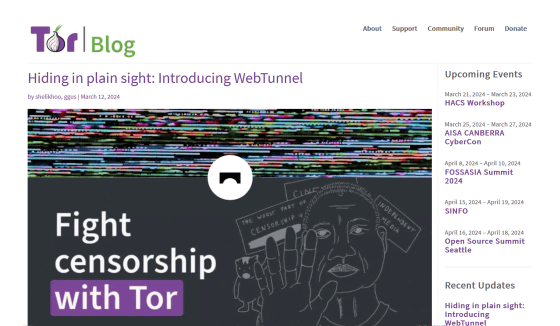Release of ``WebTunnel'', a bridge that imitates HTTPS connections to avoid censorship of Tor connections, is officially announced

Hiding in plain sight: Introducing WebTunnel | The Tor Project
https://blog.torproject.org/introducing-webtunnel-evading-censorship-by-hiding-in-plain-sight/

Tor Project | WebTunnel Bridge
https://community.torproject.org/relay/setup/webtunnel/
Tor's new WebTunnel bridges mimic HTTPS traffic to evade censorship
https://www.bleepingcomputer.com/news/security/tors-new-webtunnel-bridges-mimic-https-traffic-to-evade-censorship/
Tor maintains anonymity by accessing from the user's computer to the target website via relay points called 'relays'. A bridge is a relay that is not open to the public and has the role of hiding a user's network connection from government censorship. The Tor Project states that 'the development of different types of bridges is critical to increasing Tor's resilience to censorship and staying ahead of our opponents in a highly dynamic and ever-changing censorship environment.'
The newly released WebTunnel is a bridge designed to mimic HTTPS traffic for secure HTTP communication. To network observers, Tor traffic is indistinguishable from regular HTTPS-encrypted traffic, making it appear as though users are just browsing the web.
With a method that completely encrypts communications, the contents of the communications will not be leaked to the censors, but there is a possibility that the communications will be subject to censorship as suspicious. However, with WebTunnel, censorship itself can be avoided by making communication using Tor look like normal communication.
If you block WebTunnel, HTTPS itself, which is used for general communication, will also be blocked, making most connections to web servers impossible. Therefore, the monitor has no choice but to allow WebTunnel.
The Tor project also explained that because WebTunnel is very similar to regular web traffic, it can coexist with websites on the same domain, same IP address, and same port on the same network endpoint. .

To use WebTunnel, you must first obtain the bridge from the Tor project's official website and add it to Tor desktop or Tor for Android.
The Tor Project began recruiting testers for WebTunnel in October 2023, and has made improvements based on the extensive feedback it has received both publicly and privately. At the time of writing, 60 WebTunnel bridges are hosted around the world, and there are over 700 daily active users.
Related Posts:
in Software, Web Service, Security, Posted by log1h_ik







